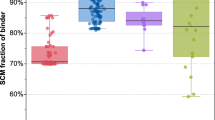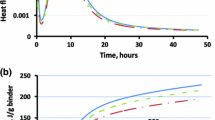Abstract
Carbonation, reactions between cementitious materials and atmospheric carbon dioxide, is one of the most important mechanisms that determine the longevity of cementitious materials. Despite the recent advances in revealing the carbonation mechanism of cement and concrete materials, the understanding of carbonation mechanisms in low-carbon cementitious materials, particularly low-clinker blended cement (clinker replacement > 60%) and alkali-activated materials, is still limited. This study compares the carbonation performances of a low-clinker blended slag cement and an alkali-activated slag cement via thermodynamic modelling. Phase assemblages of two different types of cementitious materials under accelerated carbonation conditions were predicted by thermodynamic models using the latest CEMDATA18 database. Validation of the developed models were conducted by comparing the predicted results with the experimentally characterised mineralogy from the literature. After validation, the carbonation performances of high-GGBFS blended cement and alkali-activated slag cements are critically compared.
Access this chapter
Tax calculation will be finalised at checkout
Purchases are for personal use only
Similar content being viewed by others
References
von Greve-Dierfeld, S., et al.: Understanding the carbonation of concrete with supplementary cementitious materials: a critical review by RILEM TC 281-CCC. Mater. Struct. 53(6), 1–34 (2020). https://doi.org/10.1617/s11527-020-01558-w
Gluth, G.J.G., et al.: Carbonation rate of alkali-activated concretes and high-volume SCM concretes: a literature data analysis by RILEM TC 281-CCC. Mater. Struct. 55(8), 225 (2022)
Taylor, H.F.W.: Cement Chemistry. Thomas Telford, London (1997)
Bernal, S.A., et al.: Factors controlling carbonation resistance of alkali-activated materials, vol. 320, p. 36. ACI Special Publication (2016)
Ke, X., et al.: Slag-based cements that resist damage induced by carbon dioxide. ACS Sustain. Chem. Eng. 6, 5067–5075 (2018)
Kim, J., Na, S., Hama, Y.: Effect of blast-furnace slag replacement ratio and curing method on pore structure change after carbonation on cement paste. Materials 13(21), 4787 (2020)
Lothenbach, B., et al.: Cemdata18: a chemical thermodynamic database for hydrated Portland cements and alkali-activated materials. Cem. Concr. Res. 115, 472–506 (2019)
Skocek, J., et al.: Predictive modelling of hydration and mechanical performance of low Ca composite cements: possibilities and limitations from industrial perspective. Cem. Concr. Res. 100, 68–83 (2017)
Myers, R.J., S.A. Bernal, Provis, J.L.: A thermodynamic model for C-(N-)A-S-H gel: CNASH_ss. derivation and validation. Cem. Concr. Res. 66, 27–47 (2014)
Ke, X., et al.: Thermodynamic modelling of phase evolution in alkali-activated slag cements exposed to carbon dioxide. Cem. Concr. Res. 136, 106158 (2020)
De Weerdt, K., Orsáková, D., Geiker, M.R.: The impact of sulphate and magnesium on chloride binding in Portland cement paste. Cem. Concr. Res. 65, 30–40 (2014)
Shi, Z., et al.: Experimental studies and thermodynamic modeling of the carbonation of Portland cement, Metakaolin and limestone mortars. Cem. Concr. Res. 88(Supplement C), 60–72 (2016)
De Weerdt, K., et al.: Effect of carbonation on the pore solution of mortar. Cem. Concr. Res. 118, 38–56 (2019)
Reddy, K.C., Melaku, N.S., Park, S.: Thermodynamic modeling study of carbonation of Portland cement. Materials 15(14), 5060 (2022)
Stephant, S., et al.: Influence of the slag content on the hydration of blended cement. In: 14th International Congress on the Chemistry of Cement, Beijing (2015)
Kulik, D.A., et al.: CemGEMS – an easy-to-use web application for thermodynamic modelling of cementitious materials. RILEM Tech. Lett. 6, 36–52 (2021)
Helgeson, H.C., Kirkham, D.H., Flowers, G.C.: Theoretical prediction of the thermodynamic behavior of aqueous electrolytes by high pressures and temperatures; IV, calculation of activity coefficients, osmotic coefficients, and apparent molal and standard and relative partial molal properties to 600 °C and 5 kb. Am. J. Sci. 281, 1249–1516 (1981)
Kulik, D.A.: Improving the structural consistency of C-S-H solid solution thermodynamic models. Cem. Concr. Res. 41(5), 477–495 (2011)
Li, X., Bizzozero, J., Hesse, C.: Impact of C-S-H seeding on hydration and strength of slag blended cement. Cem. Concr. Res. 161, 106935 (2022)
Vogler, N., et al.: Alternative pH-indicators for determination of carbonation depth on cement-based concretes. Cement Concr. Compos. 109, 103565 (2020)
Lo, Y., Lee, H.M.: Curing effects on carbonation of concrete using a phenolphthalein indicator and Fourier-transform infrared spectroscopy. Build. Environ. 37(5), 507–514 (2002)
Author information
Authors and Affiliations
Corresponding author
Editor information
Editors and Affiliations
Rights and permissions
Copyright information
© 2023 The Author(s), under exclusive license to Springer Nature Switzerland AG
About this paper
Cite this paper
Ke, X. (2023). Comparing the Carbonation Performances of a Low-Clinker Blended Slag Cement with an Alkali-Activated Slag via Thermodynamic Modelling. In: Jędrzejewska, A., Kanavaris, F., Azenha, M., Benboudjema, F., Schlicke, D. (eds) International RILEM Conference on Synergising Expertise towards Sustainability and Robustness of Cement-based Materials and Concrete Structures. SynerCrete 2023. RILEM Bookseries, vol 44. Springer, Cham. https://doi.org/10.1007/978-3-031-33187-9_103
Download citation
DOI: https://doi.org/10.1007/978-3-031-33187-9_103
Published:
Publisher Name: Springer, Cham
Print ISBN: 978-3-031-33186-2
Online ISBN: 978-3-031-33187-9
eBook Packages: EngineeringEngineering (R0)




